
An amphibious vehicle is a vehicle that is a means of transport viable on land as well as on or under water. Amphibious vehicles include amphibious bicycles, ATVs, cars, buses, trucks, railway vehicles, combat vehicles and hovercraft.
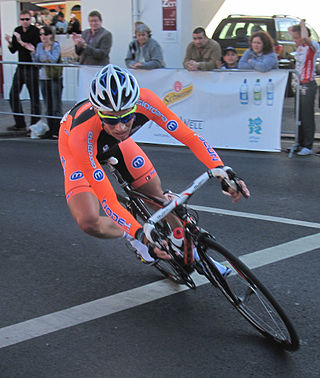
Steering is the control of the direction of locomotion or the components that enable its control. Steering is achieved through various arrangements, among them ailerons for airplanes, rudders for boats, tilting rotors for helicopters, and many more.

Ski warfare is the use of ski-equipped troops in war.
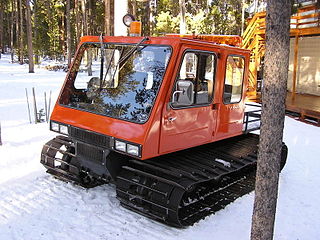
A snowcat is an enclosed-cab, truck-sized, fully tracked vehicle designed to move on snow. Major manufacturers are PistenBully (Germany), Prinoth (Italy) and Tucker.

Bandvagn 206 is a tracked articulated, all-terrain carrier initially developed and manufactured by the Swedish company Hägglund & Söner, and subsequently by BAE Systems Hägglunds, for the Swedish Army. It consists of two units, with all four tracks powered. It can carry up to 17 people, 6 in the front compartment, 11 in the rear. The trailer unit can be adapted for different uses.

BAE Systems AB is subsidiary holding company for the Swedish assets of BAE Systems Land & Armaments, whose ultimate parent is the British defence contractor BAE Systems.
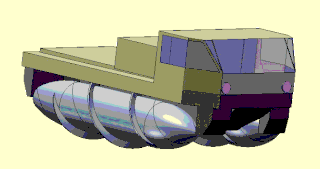
A screw-propelled vehicle is a land or amphibious vehicle designed to cope with difficult terrain, such as snow, ice, mud, and swamp. Such vehicles are distinguished by being moved by the rotation of one or more auger-like cylinders fitted with a helical flange that engages with the medium through or over which the vehicle is moving. They have been called Archimedes screw vehicles by the US military, where they are classified as a type of marginal terrain vehicle (MTV). Modern vehicles called Amphirols and other similar vehicles have specialised uses.
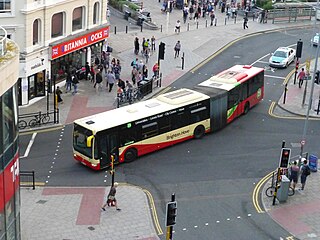
An articulated vehicle is a vehicle which has a permanent or semi-permanent pivot joint in its construction, allowing it to turn more sharply. There are many kinds, from heavy equipment to buses, trams and trains. Steam locomotives were sometimes articulated so the driving wheels could pivot around corners.

The rocker-bogie system is the suspension arrangement developed in 1988 for use in NASA's Mars rover Sojourner, and which has since become NASA's favored design for rovers. It has been used in the 2003 Mars Exploration Rover mission robots Spirit and Opportunity, on the 2012 Mars Science Laboratory (MSL) mission's rover Curiosity, the Mars 2020 rover Perseverance and ISRO's Chandrayaan-3 rover Pragyan in 2023.

The Snow Trac is a small personal Snowcat that is roughly the size of a modern compact car.

Super Select is the brand name of a four-wheel drive system produced by Mitsubishi Motors, used worldwide except for North America, where it was initially known as Active-Trac. It was first introduced in 1991 with the then-new second generation of the Mitsubishi Pajero.

Bandvagn 202 is an amphibious oversnow tracked articulated, all-terrain vehicle developed by Bolinder-Munktell, a subsidiary of Volvo, for the Swedish Army in the early 1960s.

An amphibious all-terrain vehicle, amphibious ATV, is a small, all-wheel drive, all-terrain amphibious vehicle, used for recreation, farm-, hunting, utility or industry tasks, by enthusiasts and professionals worldwide. They are legally off-highway vehicles in many countries, or at least restricted from use on express highways and motorways – their use is generally extra-urban.

The Nasu is a tracked articulated, all-terrain transport vehicle developed by Sisu Auto for the Finnish Army. It consists of two units, with all four tracks powered. It can carry up to 17 people, although the trailer unit can be adapted for different applications. There are two main versions, the NA-140 BT and the NA-110.

An articulated hauler, articulated dump truck (ADT), or sometimes a dump hauler, is a very large heavy-duty type of dump truck used to transport loads over rough terrain, and occasionally on public roads. The vehicle usually has all-wheel drive and consists of two basic units: the front section, generally called the tractor, and the rear section that contains the dump body, called the hauler or trailer section. Steering is made by pivoting the front in relation to the back by hydraulic rams. This way, all wheels follow the same path, making it an excellent off-road vehicle.
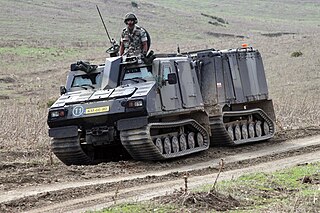
The BvS10 is a tracked articulated amphibious all-terrain armoured vehicle produced by BAE Systems Land Systems Hägglunds of Sweden. This vehicle, referred to as the All Terrain Vehicle (protected) - ATV(P) or Viking by the UK forces, was originally developed as a collaboration between industry - Hägglunds Vehicle AB - and the British Ministry of Defence (MoD) on behalf of the Royal Marines.

Raupenschlepper Ost was a fully tracked, lightweight vehicle used by the Wehrmacht in World War II. It was conceived in response to the poor performance of wheeled and half-tracked vehicles in the mud and snow during the Wehrmacht's first autumn and winter on the Soviet Front.

The Bronco All Terrain Tracked Carrier (ATTC) is a twin chassis multi-purpose tracked articulated vehicle jointly developed by ST Kinetics and the Defence Science and Technology Agency (DSTA) for the Singapore Army. The variant which was in service as a UOR with the British Armed Forces is known as the Warthog.

Grousers are devices intended to increase the traction of continuous tracks, especially in loose material such as soil or snow. This is done by increasing contact with the ground with protrusions, similar to conventional tire treads, and analogous to athletes' cleated shoes. On tanks and armoured vehicles, grousers are usually pads attached to the tracks; but on construction vehicles they may take the form of flat plates or bars.

The Vityaz DT-30 is a multi-purpose articulated tracked carrier developed in the Soviet Union. It was designed to carry heavy loads in difficult terrain like swamps, sand and snow in extreme weather conditions.





















